

New Employee Experience Index from IBM and Globoforce. Click the image to download the report and learn which practices create more human employee experiences.
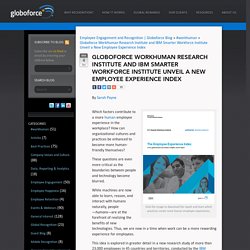
Which factors contribute to a more human employee experience in the workplace? How can organizational cultures and practices be enhanced to become more human-friendly themselves? These questions are even more critical as the boundaries between people and technology become blurred. While machines are now able to learn, reason, and interact with humans naturally, people—humans—are at the forefront of realizing the benefits of new technologies.
Thus, we are now in a time when work can be a more rewarding experience for employees. This idea is explored in greater detail in a new research study of more than 23,000 employees in 45 countries and territories, conducted by the IBM Smarter Workforce Institute and Globoforce’s WorkHuman Research Institute. Download the full report here. The HR Metric You're Not Measuring (But Should Be) New research suggests employee engagement may not tell the whole story of the employee experience at work.

For years, HR leaders and professionals have been laser-focused on measuring and improving employee engagement. In fact, Josh Bersin noted in a Forbes editorial that the roots of engagement surveys go all the way back to the late 1800s when Fredrick Taylor studied how people’s attitudes impacted their productivity in the steel industry. And we’ve been focused on engagement for good reason—it’s linked to lower turnover, fewer safety incidents, and lower absenteeism. Customer Satisfaction Without Engagement.
Story Highlights Customer engagement doesn't automatically follow satisfaction, or vice versaEngaging or satisfying customers -- or doing both -- is a strategic choiceSuccess flows from the organizational norms senior leaders create Customer engagement and customer satisfaction are distinctly different metrics.

In fact, engagement is a much higher bar to reach than satisfaction. According to Gallup's customer database, half of all customers (50%) say they are satisfied with a given brand, but only 38% of customers say they are engaged with one. 7 Fascinating Employee Engagement Trends for 2016 – Medium. What makes an employee highly engaged?
We recently bumped into an article of Red Letter Days for Business (RLD) on the engagement levels of employees in the UK.
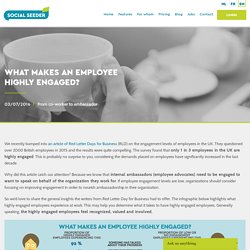
They questioned over 2000 British employees in 2015 and the results were quite compelling. The survey found that only 1 in 3 employees in the UK are highly engaged. Shawn Achor: The happy secret to better work. Bul 1316803. 17 Habits of the Most Highly Respected Employees. We've explored the things the most respected bosses do, and the inevitable habits that unhappy employees fall into.
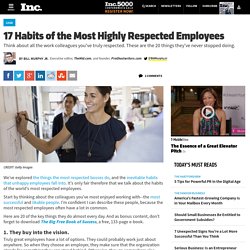
It's only fair therefore that we talk about the habits of the world's most respected employees. Start by thinking about the colleagues you've most enjoyed working with--the most successful and likable people. I'm confident I can describe these people, because the most respected employees often have a lot in common. Here are 20 of the key things they do almost every day. And as bonus content, don't forget to download The Big Free Book of Success, a free, 133-page e-book. 1. Truly great employees have a lot of options. 2. A workplace isn't a family, but it is a group of people who should be committed to each other's success. 3. As a boss, and as a colleague, there's nothing more annoying than an employee who sits on his or her hands, rather than tackling jobs that need to be done--regardless of whether the job is technically within that person's job description.
Managers: Millennials Want Feedback, but Won't Ask for It. Story Highlights Millennials require more feedback than do other generationsRegular meetings more than double the likelihood of engagementManagers should connect with employees on a daily basis All employees want some type of feedback from their manager.
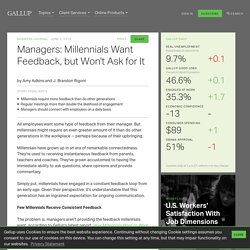
Kerwin Rae - Journal. Fastcompany. Most of us learned to say thank you at an early age.
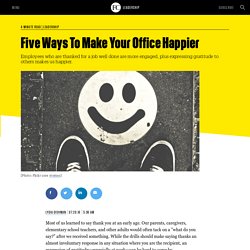
Our parents, caregivers, elementary school teachers, and other adults would often tack on a "what do you say? " after we received something. Tutorials & Lessons On Employee Engagement, Culture, Management. The Common Sense Guide to Employee Engagement. Much attention has been paid to engaging employees in recent years.

And for good reason, given the shockingly low engagement levels reported study after study. But is anything really helping? Has the arrival of enterprise social network software platforms made any difference? The truth is, employee engagement has not really improved for decades. Partly because there are some major shifts in technology and globalization well underway: Companies are more dispersed across locations Employees are more mobile and work from home more often There is more information, everywhere, competing for our attention These realities make engagement more challenging, and although new tools have arrived, they haven’t really changed what it takes to engage an employee.
The fundamentals remain the same: if you want to engage your employees, you need to actually focus on them and address their core workplace needs. Core Human Workplace Needs People are people. How Can You Meet These Needs? 1. The New Rules of Employee Engagement: From Pre-Hire to Post-Employment. I am one lucky guy when it comes to work.
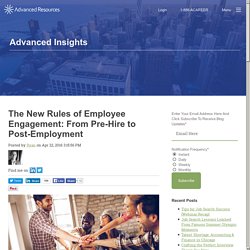
I love what I do and I love the company I do it for. And apparently I am not alone. 7 Reasons the Best Employees Quit, Even When They Like Their Job. Losing a great employee is a terrible thing.
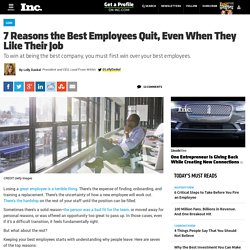
There's the expense of finding, onboarding, and training a replacement. There's the uncertainty of how a new employee will work out. There's the hardship on the rest of your staff until the position can be filled. Sometimes there's a solid reason--the person was a bad fit for the team, or moved away for personal reasons, or was offered an opportunity too great to pass up.
In those cases, even if it's a difficult transition, it feels fundamentally right.